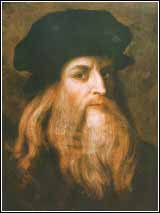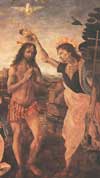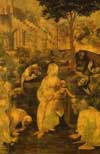|
Biography 1452-1500
Childhood
 Leonardo Da Vinci was born on April 15, 1452 in the small Tucson town
of Anchiano, near Florence. His parents, Ser Piero, a notary, and Caterina,
a peasant woman, were unmarried, and the illegitimate Leonardo was raised
by his father. Some experts claim that due to his illegitimacy Leonardo
was unworthy of a proper education, and that this is the reason that he
did not follow in his father's footsteps to become a notary, or why he
did not study to become a doctor. Meanwhile, other Da Vinci sources claim
that the young Leonardo was treated as a legitimate child, and was offered
the same education as other children of that day.
Leonardo Da Vinci was born on April 15, 1452 in the small Tucson town
of Anchiano, near Florence. His parents, Ser Piero, a notary, and Caterina,
a peasant woman, were unmarried, and the illegitimate Leonardo was raised
by his father. Some experts claim that due to his illegitimacy Leonardo
was unworthy of a proper education, and that this is the reason that he
did not follow in his father's footsteps to become a notary, or why he
did not study to become a doctor. Meanwhile, other Da Vinci sources claim
that the young Leonardo was treated as a legitimate child, and was offered
the same education as other children of that day.
Apprenticeship and First Florentine Period
At the age of 15 Leonardo had already mastered skills in the fine arts
and the young man was sent to Florence to work as an apprentice in the
renowned workshop of Andrea del Verrocchio.
 Leonardo
worked with del Verrocchio until 1477, during which time del Verrocchio
had been commissioned for a painting that would be The Baptism of Christ,
and the painter had Leonardo aid him with the work by having his pupil
paint the kneeling angel in the painting. Leonardo's angel was so outstanding
that it shadowed del Verrocchio's portion of the work, and Leonardo is
quoted to have later stated that "poor is a pupil that does not surpass
his master." It is also said that Andrea del Verrocchio gave up his
career as a painter, having suffered such humiliation by being out-painted
by his own student.
Leonardo
worked with del Verrocchio until 1477, during which time del Verrocchio
had been commissioned for a painting that would be The Baptism of Christ,
and the painter had Leonardo aid him with the work by having his pupil
paint the kneeling angel in the painting. Leonardo's angel was so outstanding
that it shadowed del Verrocchio's portion of the work, and Leonardo is
quoted to have later stated that "poor is a pupil that does not surpass
his master." It is also said that Andrea del Verrocchio gave up his
career as a painter, having suffered such humiliation by being out-painted
by his own student.
In 1472, while still working with del Verrocchio, Leonardo Da Vinci was honored as he was accepted into the painter's guild of Florence.
 After
leaving Verrocchio's studio, Leonardo remained in Florence where he worked
independently until 1481. In his final years in Florence, Leonardo Da
Vinci received two substantial commissions. The first was for the painting
The Adoration of the Magi for the monastery of San Donato a Scopeto;
and the second was for a painting that was to be completed in the Altar
of St. Bernard Chapel in the Palazzo della Signoria. The first painting
was never completed and the second, Leonardo never even began, abandoning
the projects to move to Milan.
After
leaving Verrocchio's studio, Leonardo remained in Florence where he worked
independently until 1481. In his final years in Florence, Leonardo Da
Vinci received two substantial commissions. The first was for the painting
The Adoration of the Magi for the monastery of San Donato a Scopeto;
and the second was for a painting that was to be completed in the Altar
of St. Bernard Chapel in the Palazzo della Signoria. The first painting
was never completed and the second, Leonardo never even began, abandoning
the projects to move to Milan.
While Leonardo's career seemed to be taking flight, his reputation was damaged in 1481 when he was charged with sodomy. Though the charges were later dropped, the public humiliation may have played a role in Da Vinci's abandonment of these commissions. His humiliation was even more so accentuated when Leonardo was not chosen amongst those commissioned to paint the Sistine Chapel.
First Milanese Period
In 1482, Leonardo Da Vinci moved to Milan where he had been hired by the
city's duke, Duke Ludovico Sforza, and had been given the title of "painter
and engineer of the duke." He worked as a painter, sculptor, served
as an architect, and he aided in the design of fortifications and military
conceptions. Da Vinci would remain in Milan for 17 years, leaving his
position with the falling out of power of the Duke with the entry of the
French into Milan.
During this first Milanese period Leonardo completed at least six works. Among these works are, from 1483-1486, The Virgin of the Rocks, (which now has a home in the Louvre in Paris) and the monumental The Last Supper between 1495-1498. The extremely difficult to visit painting remains on the walls at the refectory of the Santa Maria delle Grazie, and is one of the most widely sold Da Vinci Posters of all time.
Read more about Leonardo Da Vinci’s life from 1500-1519.
See another Leonardo Da Vinci biography on www.leonardodavinci.net.
